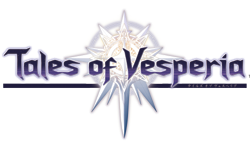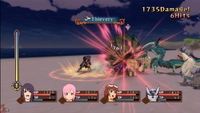|
|

|
PLATFORM
|
360
|
BATTLE SYSTEM
|

|
INTERACTION
|

|
ORIGINALITY
|

|
STORY
|

|
MUSIC & SOUND
|

|
VISUALS
|

|
CHALLENGE
|
Adjustable
|
COMPLETION TIME
|
More than 80 Hours
|
|
OVERALL

|
+ Great action RPG battle system
- Occasionally annoying AI
+ Well paced plot
+ Great aesthetics
- Easy-to-miss gear
+ Abundance of extra content
|
Click here for scoring definitions
|
|
|
Before the advent of the N64, Namco's Team Wolf squeezed out Tales of Phantasia for the Super Famicom in 1995. Since then, the Tales series has evolved to become a relatively noticeable Namco series, particularly after the success of Tales of Symphonia for the GameCube. Tales of Vesperia--the latest console project from Team Symphonia--brings Tales into the seventh generation of consoles, starting with the Xbox 360.
Since its conception in 1995, the Tales series has featured games with very robust action battle systems. Vesperia keeps the series' traditional Linear Motion Battle System, but, like Tales of the Abyss, the linear path to the target can be adjusted to a 3D roam, so front line monsters can be side-stepped. As with other Tales games, combat boils down to knowing when to attack, how to attack, and when to defend. With hundreds of skills and dozens of abilities, strategy and skill fuse to create a simple but rewarding battle system. In battle, only the party leader can be controlled by the player. Up to three more players can join in, but the game's AI handles the non-player-controlled party members. The AI is fairly customizable, but still not a substitute for a human, especially when it comes to characters with healing artes. Overall, the AI rarely jeopardizes battles, and the game allows for players to change strategies in battle, order the use of specific artes, and change the party leader in battle (so long as the proper key item has been unlocked).
Besides well designed combat, the featured storyline deserves praise. For such a long game, the story maintains momentum by avoiding long-term use of the typical "chase the villain around" or "collect ____" scenarios&mdashthough the very beginning and ending of the game utilize each, respectively. Bit by bit, the plot threads unravel with only a few low points. While many of the actually story elements are not particularly original, the general use and pacing creates a fairly enjoyable story. Likewise, the cast of characters enlist several clichés but in a well thought out way. The lead hero Yuri breaks away from the typical goody-goody teenager mold and instead focuses on meting out an independent justice that borderlines on a "dark justice." The other party members come cut from familiar cloth, but many seem more tolerable in Vesperia, such as the hyperactive preteen boy Karol.
 Or anyone at all!
Or anyone at all!
|
|
In Vesperia, weapons and sub-weapons possess various abilities, which are permanently learned through learning points gained in battle. As long as the gear is equipped, the abilities are automatically active; however, limited skill points must be allotted to equip learned abilities without the proper gear. Unfortunately, weapon-based skill learning comes with some rough edges. With hundreds of weapons and weapon variations produced with synthesizing, missing some weapons can jeopardize the development of certain characters. Many late game weapons teach the technique needed to perform each characters' ultimate arte and teach the attributes that upgrade older offensive artes, and missing these weapons can cripple a character late game, especially for those willing to tackle some of the game's greatest challenges. This system also endorses a lot of grinding, first in order to rack up enough money to be able to afford more new weapons and variations and then to learn said weapons' skills. For more casual players speeding through the game, this system might prove annoying.
Like the entries developed by Team Symphonia as well as Tales of Phantasia, manga artist Kosuke Fujishima lends his talents to the cast's designs. Like Namco-Bandai's Eternal Sonata, the art comes to life as each model looks like Fujishima's art ripped from the pages and given dimension. While not quite as accentuated as Eternal Sonata, the characters and world are finely shaded and exhibit the whole gamut of colours; brown only makes up a small portion of the game's pallet. A decent multitude of alternate costumes (and actual new costumes, not pallet-swaps) and unlockable design accessories allow players to have some impact on their party's presentation in battle and in most cutscenes.
Following series tradition, Vesperia features a new soundtrack by Motoi Sakuraba. The music serves as a background rather than a frontal part of the presentation. The only time the score kicks into gear is during battle, and the battle themes change over the course of the game to reflect changes in the story's direction. While sound background music, the music does not change in the middle of a dialogue scene, harming the overall drama. Surprisingly, the English voice acting compensates for any flaws in the score. A large portion of the game features voice acting, and, unlike previous Team Symphonia games, the English dub covers the hundreds of skits. The voices fit their character like a glove and avoid the more abrasive vocal traits used for clichéd character archetypes, such as overly high pitches for younger male characters and delicate heroines. Unlike Eternal Sonata, Vesperia only includes the English dub, but the dub exceeds expectations given some past voice work in Namco-Bandai dubs.
 Beware of furry pickpockets.
Beware of furry pickpockets.
|
|
Vesperia offers players a long, bountiful experience. While the main storyline can be completed in about sixty and seventy hours, the abundant side-quests can rack up dozens of extra hours. Hundreds of little bonus cutscenes and events lay hidden through the game for fans to pick up along the way as they explore and train up new abilities. The game's pace and challenge remains fairly consistent with the player's selected difficulty level, though an occasional boss may trip up players coasting through the game. However, the true game's challenge, regardless of difficulty, lies in the Fel Arms quest, an endgame challenge to collect the party's finest weapons. Completing the quest grants great power at a terrible price, as the final boss gains an incredibly formidable third phase. The adjustable difficulty and level of optional content lets players to decide their adventure's length and difficulty.
Ultimately, Tales of Vesperia stands as a solid example of how to handle JRPGs on a current generation system. The frantic yet satisfying battle system is only marred by the most minuscule AI hiccups. The plot, while still littered by traditional clichés, shades the adage, "The sum is greater than its parts," and pitch-perfect aesthetics compliment the story. Lastly, the fairly liberal adjustment in difficulty and length enables players to tailor the game more to their liking. Easily, the largest complaint can be lobbed towards the skill system, but the skill system alone cannot spoil Tales of Vesperia.
Review Archives
|









